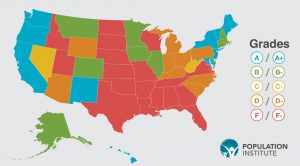After a Year of Trump Policies, Population Institute’s Report Card on Reproductive Health/Rights for 2017 Lowers Overall U.S. Grade to a “D-”
18 States Get Failing Grade Amid Attacks on Family Planning and Birth Control

On the heels of the Trump administration’s proposed 2019 budget, which seeks to slash support for reproductive health programs, the Population Institute today released its sixth annual report card on reproductive health and rights in the U.S. The results were alarming, showing declining overall reproductive health and rights and growing disparities between states after the first year of Trump policies. For 2017, the overall U.S. grade fell from a “D” to a “D-.” 18 states got a failing grade.
These findings reflect sharp differences in the way states handle family planning and reproductive health programs, as well as stepped up attacks on those programs by the Trump administration. “The Trump administration and its allies in Congress have escalated the assault on reproductive health and rights,” said Robert Walker, president of the Population Institute. “At the state level, we are seeing a deep and growing divide between states that seek to protect reproductive health and rights and those that do not. States with good grades are gradually improving, while states with poor grades are showing little or no improvement.
The National Grade
The national grade this year fell from a “D” to a “D-“, reflecting escalating attacks on reproductive health and rights at the federal level.
The Trump budget proposal unveiled this week signals worse attacks to come. It would eliminate the Teen Pregnancy Prevention Program, invest in ineffective abstinence-only education programs, and block patients from seeing their preferred health care provider, Planned Parenthood.
Over the past year some Trump administration attacks on reproductive health and rights were blocked, at least temporarily, including a proposed 20-week abortion ban and attempted defunding of Planned Parenthood. But other attacks were carried out.
The Administration diluted the Affordable Care Act’s “contraceptive mandate” by issuing a regulation that enables employers and insurers to delete coverage of contraceptives in their insurance policies, for any religious or moral reason, without even notifying the government. Last year, with Trump administration backing, Congress blocked implementation of an Obama-era regulation prohibiting states, under Title X, from defunding Planned Parenthood and other abortion providers. This year, the Trump administration is seeking to help states terminate Planned Parenthood as a healthcare provider for Medicaid beneficiaries.
Reproductive rights also suffered a judicial setback in 2017 with the confirmation of President Trump’s nomination of Neil Gorsuch to the U.S. Supreme Court and the nomination and confirmation of several district and appellate court justices to the federal bench.
State Grades
First, the good news: Twenty-two states received a B- or higher in 2017. Eleven states (California, Washington D.C., Hawaii, Maine, Maryland, New Jersey, New Mexico, New York, Oregon, Vermont, and Washington) received an “A” in 2017, up from five the year before. The improved showing was largely attributable to state declines in the rate of teenage pregnancy.
But the bad news highlights growing national disparity: 27 states received a “D” or lower. 18 of those states received a failing grade (“F”), including Alabama, Arkansas, Florida, Georgia, Idaho, Kansas, Louisiana, Mississippi, Missouri, Nebraska, North Dakota, Oklahoma, South Dakota, Tennessee, Texas, Utah, Virginia, and Wisconsin.
Understanding the Results
“A woman’s reproductive health and rights should not depend on what state or county she lives in, but increasingly, it does,” said Walker. “This report card shows the disparities are large and growing, as access to abortion services is getting curtailed in many states.” In 26 states today more than 50 percent of the women live in a county without an abortion provider. “The proposed Trump budget would only exacerbate this divide,” he said.
“There is some good news in the midst of all this,” said Walker. “America’s unintended pregnancy rate is the lowest it has been in 30 years and we have reached an historic low in the teen pregnancy rate. But that progress cannot be taken for granted, as the Trump administration made clear with their recent budget. If birth control opponents are ultimately successful in defunding Title X family planning clinics and evidence-based sex education programs, we should expect an increase in both teen and unintended pregnancies.”
“The United States is in danger of becoming, in effect, the Divided States of Reproductive Health and Rights,” said Walker. “We cannot let that happen. All those who are concerned about the state of reproductive health in America should be making their voices heard.”
Methodology
Using eleven criteria, the Institute’s report card ranked each of the 50 states and the District of Columbia:
· Thirty percent of the grade is based on measures of effectiveness. This includes the latest available data on the teenage pregnancy rate (15%) and the rate of unintended pregnancies (15%).
· Twenty-five percent of the grade is based upon prevention. This includes mandated comprehensive sex education in the schools (15%), access to emergency contraception (5%), and minors’ access to contraceptive services (5%).
· Twenty-five percent of the grade is based upon affordability. This includes if states are expanding Medicaid under the Affordable Care Act (15%), Medicaid eligibility rules for family planning (5%), and restrictions of insurance coverage of abortion (5%).
· The final 20 percent of the grade is based upon clinic access. This includes abortion restrictions (10%), TRAP Laws (5%), and percent of women living in a county without an abortion provider (5%).
Based upon their scores, each state received a “core” grade (A, B, C, D or F), but some states received an additional “plus” or a “minus” for factors not reflected in the core grade.
# # #
For a copy of the report, including a state-by-state breakdown, visit the Population Institute’s website (www.populationinstitute.org/reportcard). For questions about the report, call Jennie Wetter, Director of Public Policy, at (202) 544-3300, ext. 108.
A special thanks to the Guttmacher Institute whose research made this report card possible.